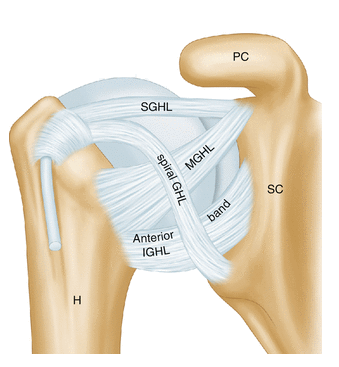Shoulder Anatomy
· 2 min read
My notes on shoulder anatomy because of an injury while Bouldering. Heard a popping noise in my shoulder in a dynamic movement on an inclined wall.
Basics
- Ligament connects bones
- Tendon connects bone and muscle
- Fracture: injury to the bone
- Sprain: injury to the ligament
- Strain: injury to the tendon
- Joints: defines movement of bones based on the joint type.
Bones
- Clavicle: aka collarbone.
- Humerus: aka upperarm bone or bone beneath the bicep.
- Scapula: aka Shoulder blade

Note: Acromion and Coracoid Process belong to Scapula.
Joints
- Glenohumeral joint (GHJ): connecting Glenoid fossa of scapula and Humerus of upper arm bone.
- Acromionclavicular joint (ACJ): connecting acromion of scapula with clavicle of collar bone.
- Sternoclavicular joint (SCJ): connecting sternum with clavicle.
- Scapulothoracic joint (STJ): connecting scapula with rib cage.

Ligaments
Ligaments are generally named based on the bones they connect aka joints. In case of scapula, the ligaments are present at acromion and coracoid process, so they are named based where they are and which other bone they connect.
Ligaments that connect glenoid fossa of scapula and humerus of upper arm bone.

Ligaments that connect Acromion, Coracoid Process of scapula with one another and also with clavicle and Humerus.

Ligaments that connect clavicle and sternum.

Tendons
- Biceps tendon
- Rotary cuff muscles tendons:
- Supraspinatus: muscle above the scapular spine
- Infraspinatus: muscle below the scapular spine
- Teres major and minor
- Subscapularis

Treatments
- Conservative aka Physio
- Arthroscopy: Surgery
Interesting Websites
- https://www.slicer.org/
- https://visualanatomy3d.app/
- https://anatomy3datlas.com/
- https://anatomylearning.com/